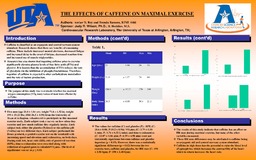
ATTENTION: The works hosted here are being migrated to a new repository that will consolidate resources, improve discoverability, and better show UTA's research impact on the global community. We will update authors as the migration progresses. Please see MavMatrix for more information.
Show simple item record
| dc.contributor.author | Rey, Amber D. | |
| dc.contributor.author | Romero, Brenda | |
| dc.date.accessioned | 2017-04-20T20:28:17Z | |
| dc.date.available | 2017-04-20T20:28:17Z | |
| dc.date.issued | 2016 | |
| dc.identifier.uri | http://hdl.handle.net/10106/26617 | |
| dc.description | KINE 4400 | en_us |
| dc.description.abstract | Caffeine is classified as an ergogenic and central nervous system stimulant. Research shows that there are benefits of consuming caffeine. These include increased mental alertness, decreased fatigue and increased delay to the onset of fatigue, decreased reaction time and increased use of muscle triglycerides.
Research has also shown that ingesting caffeine prior to exercise significantly elevates plasma levels of free fatty acids (FFA) and glycerol. It is known that the accumulation of FFA reduces the rate of glycolysis via the inhibition of phosphofructokinase. Therefore, ingestion of caffeine is expected to alter carbohydrate metabolism and the rate of lactate production. | en_US |
| dc.description.sponsorship | Faculty Sponsor, Judy R. Wilson | en_US |
| dc.description.sponsorship | Faculty Sponsor, B. Heddins | en_us |
| dc.language.iso | en_US | en_US |
| dc.subject | Maximal oxygen consumption | en_US |
| dc.subject | Bruce protocol | en_US |
| dc.subject | Heart rate | en_US |
| dc.subject | Rate of perceived exertion | en_US |
| dc.title | THE EFFECTS OF CAFFEINE ON MAXIMAL EXERCISE | en_US |
| dc.type | Presentation | en_US |
| dc.publisher.department | Department of Kinesiology, The University of Texas at Arlington | en_us |
| dc.publisher.department | Exercise Science Research Laboratories, The University of Texas at Arlington | en_us |
| dc.publisher.department | Cardiovascular Research Laboratory, The University of Texas at Arlington | en_us |
Files in this item
- Name:
- Rey Romero.pdf
- Size:
- 429.7Kb
- Format:
- PDF
- Description:
- PDF
This item appears in the following Collection(s)
Show simple item record


